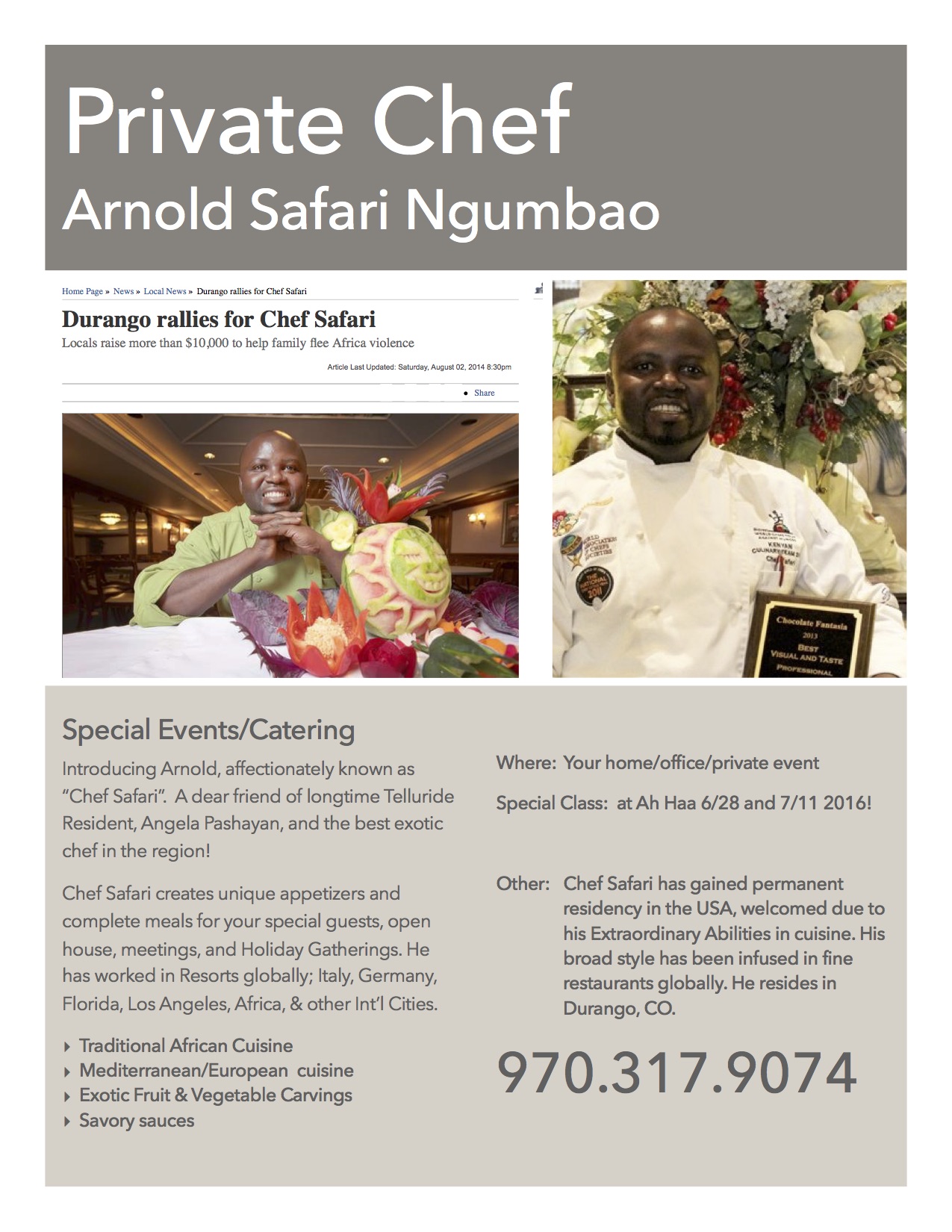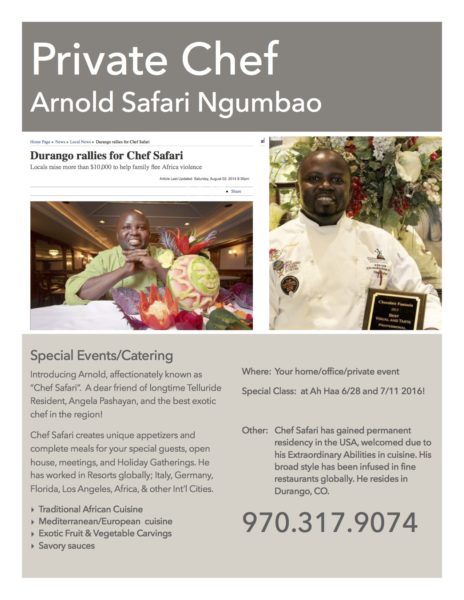
24 Jun Ah Haa: Kenyan Chef Safari Ngumbao
Kenya, a country twice the size of Nevada, is located in East Africa near the Equator. Its regions are varied and range from year-round snow in the Kenya and Kilimanjaro Mountains to warm, tropical beaches and deserts, but most of the land is rolling grasslands and forests.

When the Portuguese arrived in 1496 on the coast of Kenya, they introduced foods from newly discovered Brazil: maize, bananas, pineapple, chilies, peppers, sweet potatoes, and cassava became local staples. The Portuguese also brought oranges, lemons, and limes from China and India, also pigs.
Pastoralism (cattle herding) has a long history in Kenya. Around A.D. 1000, a clan from North Africa called the Hima introduced cattle herding. By the 1600s, groups like the Maasai and Turkana ate beef exclusively. Cattle provided meat, milk, butter, and blood.
When the Europeans arrived at the shores of Kenya, they brought white potatoes, cucumbers, and tomatoes. The British imported thousands of Indians for labor, and curries, chapattis (a flat, disk-shaped bread made of wheat flour, water, and salt) and chutneys (a relish made of spices, herbs, and/or fruit) became a traditional Sunday lunch for many Kenyans.
Kenya is a multi-racial society, the majority of the population is native ethnic groups; the rest of the population is Asian, Arab, and European. Traditional Kenyan foods reflect the many different lifestyles of these various populations.
Find out more when Chef Safari Ngumbao teaches two classes at Telluride Ah Haa School for the Arts this summer. On Tuesday, June 28, 10 a.m. – 2 p.m., the class is Food Art: Fruit & Vegetable Carving. Register here.
“Learn the art of decorative fruit and vegetable carving from a master. In this hands-on class, Kenyan chef Safari Ngumbao will lead his students in the carving of a variety of fruits and vegetables, from watermelon and beetroot to peppers and zucchini. Carve images in melons and make flowers out of vegetables for your next dinner party. Once you’ve mastered your carving skills, the options are endless!”
On Monday, July 11, 10 a.m. – 2 p.m., Chef Ngumbao leads Traditional African Cuisine: Appetizers, Spices & Their Uses. (Note: This class will not be held at Ah Haa. The private home will be announced shortly.) Register here.
“Explore the exotic cuisine of Africa with Kenyan chef Safari Ngumbao. Students in the class will learn how to make two popular African appetizers – Mombasa beef sambusa with mango chutney and Zanzibar spiced vegetable puffs. Sambusas, sometimes called samosas, are triangular-shaped savory pastries fried in oil. These delicious snacks are commonly served during African wedding ceremonies. Zanzibar, an archipelago off the coast of East Africa, is sometimes referred to as one of the Spice Islands. The wonderful spiced vegetable puffs named for this part of Tanzania were a favorite of one of the Sultans of Oman. Come learn more about Africa’s culinary culture and its tasty spices with Safari, a seasoned chef and teacher, and the award-winning executive chef at Durango’s Strater Hotel.”
How Chef Ngumbao came to Telluride:
Short answer: Angela Pashyan through Sydney Denman.
According to Angela:
“I’ve been working internationally on humanitarian, economic, and social projects since 2006. Recently, much of my work has been in Kenya. Yet I met Mr. Arnold ‘Safari’ Ngumbao right here in Telluride.
Here’s the story.
The accountant from Cosmo Restaurant (Sydney Denman) contacted me. We both belong to Christ Church and she knew of my work in Kenya from presentations over the years. She asked if I could help someone from Kenya gain permanent residency in the U.S., and wanted me to meet him that same day. She led me to Cosmo where I spoke with the owner (Chad) who introduced me to Master Chef Safari. I greeted him with a few words in Swahili, which made him feel comfortable and at home with me. Chad wanted him to work at Cosmo, but as we talked more, I discovered he was living and working in Durango on a sponsored visa from the Strater Hotel/Restaurant. Unfortunately that meant he needed to remain in Durango during the green card process.
“What was fortunate was that I’d worked with the Kenyan Embassy on other matters and developed a friendship with an attorney here in America who could be of great assistance. I contacted him and we both got started on requirements and paperwork needed for Chef Safari’s application. Chef Safari provided many supporting documents as to his excellency in cooking, creating menus, managing a kitchen and staff, educational training, and his culinary travels. The application was presented in May 2015, and Safari had his green card in March 2016…Not only for him but for his whole family.
Although Chef Safari’s family is well settled in Durango, he loves Telluride. Our community values culinary delights and Safari does not disappoint. He visits frequently and welcomes invitations to cook at parties or special events. He is more than happy to offer cooking classes, like the two classes coming up a Ah Haa offered in a private home June 28th and July 11th. How often do you get to taste the flavors of Kenya? One mouthful takes you out of this world! My favorite dish is Pilau, what’s yours?”


Sorry, the comment form is closed at this time.